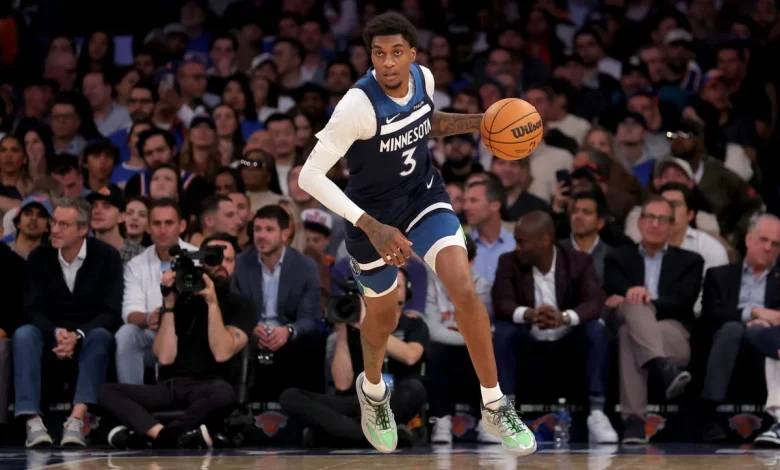Timberwolves’ Jaden McDaniels shows he’s more than just a defensive stopper

For years, Jaden McDaniels has understood how opposing defenses viewed him. He could see it in the way they guarded him. He could see it in who they put on him.
Anthony Edwards always drew the opponent’s best perimeter defender. Karl-Anthony Towns and Julius Randle, the two supporting actors to Ant’s starring role in the Minnesota Timberwolves movie, would get the toughest big man. Meanwhile, McDaniels would often see the weakest link standing in front of him.
The message to McDaniels was simple: You are not a threat, so we do not need to guard you.
In his first five seasons, McDaniels never averaged more than 12.2 points per game. He shot under 50 percent from the field. There were promising moments here and there, but the most significant contribution McDaniels was making, by far, was on the defensive end. He earned a five-year, $136 million contract extension thanks mainly to his emergence as one of the best defenders in the league.
Now in Year 6, McDaniels is showing the potential to be so much more. Through 11 games, he is averaging a career-high 18.4 points per game on shooting splits of 55/58/84. It has been an offensive awakening that changes everything about what’s possible for him and the Timberwolves going forward.
McDaniels is leading the NBA in 3-point accuracy, but the optimism surrounding his offensive game is rooted far deeper than a season-opening heater from behind the arc. He is putting the ball on the floor, getting to the rim, finding teammates with assists and creating shots for himself.
Most importantly, his 21.3 usage percentage is five full points higher than his previous career high, which means the Timberwolves are making him a more featured part of their offense and not just banishing him to the corner.
“We’re going to keep giving him the ball, putting the ball in his hands,” Edwards said. “He can play with the ball in his hands; he’s just got to make the right play. If he makes the right play, we can be 10 times better, you know? Because he’s a great scorer. We just need him to be another facilitator for us.”
STOP JUMPING WITH SLIM. pic.twitter.com/FbF3jNVm13
— Minnesota Timberwolves (@Timberwolves) November 11, 2025
In many ways, this is the role that coach Chris Finch always envisioned for him. Not long after he took the Timberwolves job, Finch started telling people that McDaniels had the potential to be Minnesota’s version of Scottie Pippen. That, of course, would require him to be more than just an elite defender. He would have to be a real threat on offense as well.
In the summer of 2024, Finch and the Wolves coaching staff were moving ahead with plans to put the ball in McDaniels’ hands a little more. He was coming off an impressive playoff performance that spring and appeared ready for a larger role. However, Minnesota traded Towns to New York for Randle and Donte DiVincenzo right before the start of training camp. The desire to empower McDaniels suddenly had to take a back seat to helping Randle and DiVincenzo acclimate to their new surroundings, thereby delaying his planned ascension.
So McDaniels did what he always does, brushing aside any disappointment and heading into last summer with even more determination to round out his game and report back ready to grab a bigger piece of the pie. He has long been one of the team’s hardest workers, often staying in Minneapolis for most of the summer with Naz Reid to hone his skills and prepare for the upcoming season.
This summer was spent focusing on improving his handle, so he could dribble through traffic in the half court and on his jumper, which has been pure as can be early this season.
SLIM TRIPLE. pic.twitter.com/zuQFyAvXPT
— Minnesota Timberwolves (@Timberwolves) November 11, 2025
The result has been a smoother-looking stroke that McDaniels is letting rip more confidently, whether he is in the corner or above the break.
“You can tell he’s been working,” Edwards said after McDaniels went 3 of 4 from 3 in a season-opening win over Portland. “The first five years of his career it was kinda flat. (Against Portland) he got some arc on the ball. It looked like he knows it’s going in now. That comes from working.”
McDaniels has found comfort in familiarity. For the first time during Tim Connelly’s four-year tenure as president of basketball operations, the Wolves did not make a major trade that shook up the roster. They brought back all but one of their top nine players, and McDaniels said that has strengthened his belief in his shot.
“It’s the same shot. Just shoot a little bit higher and just having confidence,” McDaniels said. “Just letting it go, and not worrying about the outcome. So I feel like that’s the biggest part.”
In his formative years, the Wolves tried to turn McDaniels into a 3-and-D Bruce Bowen-type. They would park him in the corner, where he would wait for kickouts from Edwards and launch away. Nearly half of his shot attempts in his second season were from 3-point range despite just a 31.7 percent conversion rate.
There was a glimmer of hope in Year 3 that McDaniels was settling into that role when he hit 39.8 percent from deep, but that proved to be the exception and not the rule. He made 33 percent of his 3s in each of the next two seasons, putting a ceiling on his offensive impact.
This season, his shot diet is much more varied. His 3.5 3-point attempts per game are perfectly in line with his career average. However, he is now taking 12.7 total shots per game, meaning a higher percentage of his offense is coming from inside the arc. All of that work on his handle appears to be paying off.
JMAC ATTACK. pic.twitter.com/l2A6hq1hGq
— Minnesota Timberwolves (@Timberwolves) November 10, 2025
“You might see me in a couple sets here and there now, just not being in the corner,” McDaniels said. “But even if I’m in the set or not just staying aggressive when I get the ball or being aggressive in transition, and just trying to do other things and just be inside the play, just be out there changing the game.”
His offensive leap has had a profound impact on the Wolves’ offense as a whole. Minnesota has the fourth-ranked offensive rating in the league (120.0 points per 100 possessions), just a tick below the New York Knicks (120.1), which pounded Minnesota at Madison Square Garden last week. Some of that could be related to a relatively soft schedule of late, but McDaniels did score 25 in a loss to the Denver Nuggets and 30 in a loss to the Los Angeles Lakers — both without Edwards — at the end of October.
The starting lineup of DiVincenzo, Edwards, McDaniels, Randle and Rudy Gobert has the highest net rating in the league. The Wolves also lead the league in 3-point accuracy, with Edwards also hitting 50 percent of his 3s. McDaniels is one of the team’s best cutters in the half court as well, which usually helps breathe life into the Wolves’ offense when it gets stagnant.
“We know that he has this in him,” Finch said. “We just have needed him to keep growing, be aggressive and, when we have ball movement, he’s going to have these games. We’ve always said that, and that’s the easiest way for us to get him involved.”
His timing has been sharp, too. The Wolves were sluggish on the second night of a back-to-back in Utah on Monday, leading the Jazz by single digits as late as the third quarter, thanks, in large part, to McDaniels missing six of his first eight shots. However, he came alive in the fourth quarter, scoring 12 of his 16 points to help Minnesota run away with it.
“When you have shooting threats like he is, scoring threats like he is, and the shooting personnel we have around and somebody like me that rolls to the basket, it forces teams to make tough decisions,” Gobert said.
If he keeps this up, opposing defenses will have to adjust. He is becoming too talented for coaches to get away with hiding one of their worst defenders on. And when they start to devote more attention to him, it should open up even more for Edwards and Randle. If he can sustain himself as a genuine third scoring threat, the Timberwolves become a big problem in the West.
McDaniels is no longer an afterthought in the Wolves’ offense. He is no longer a vacation for the other team to guard. He is a priority in Minnesota now.
“He’s one of the best two-way players in the league,” Randle said. “We’ve got to be consistent in that and keep feeding him confidence, trusting him.”





